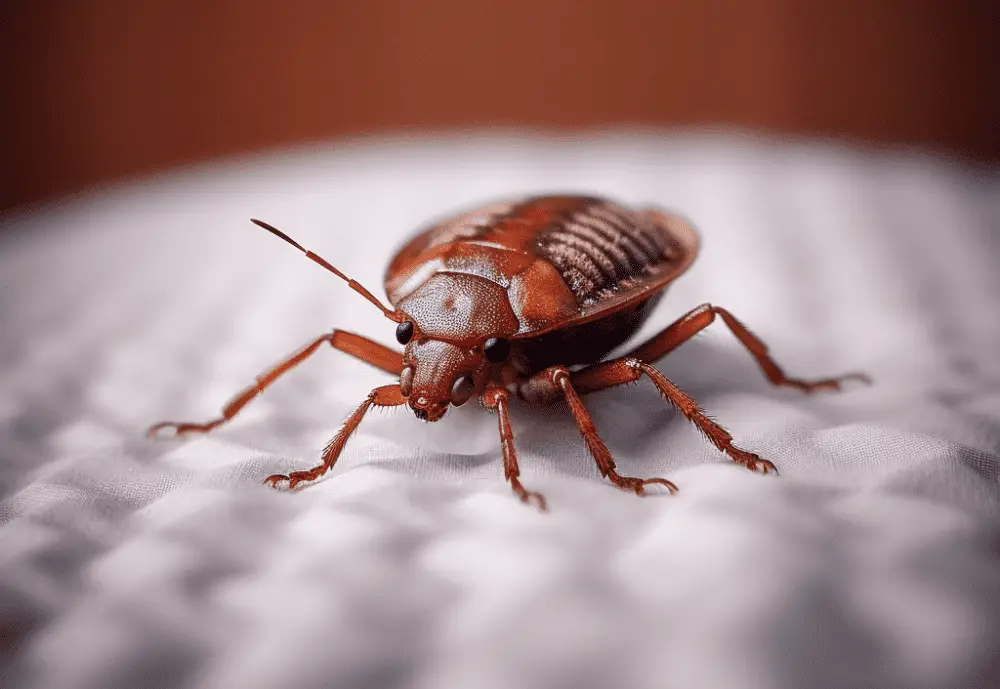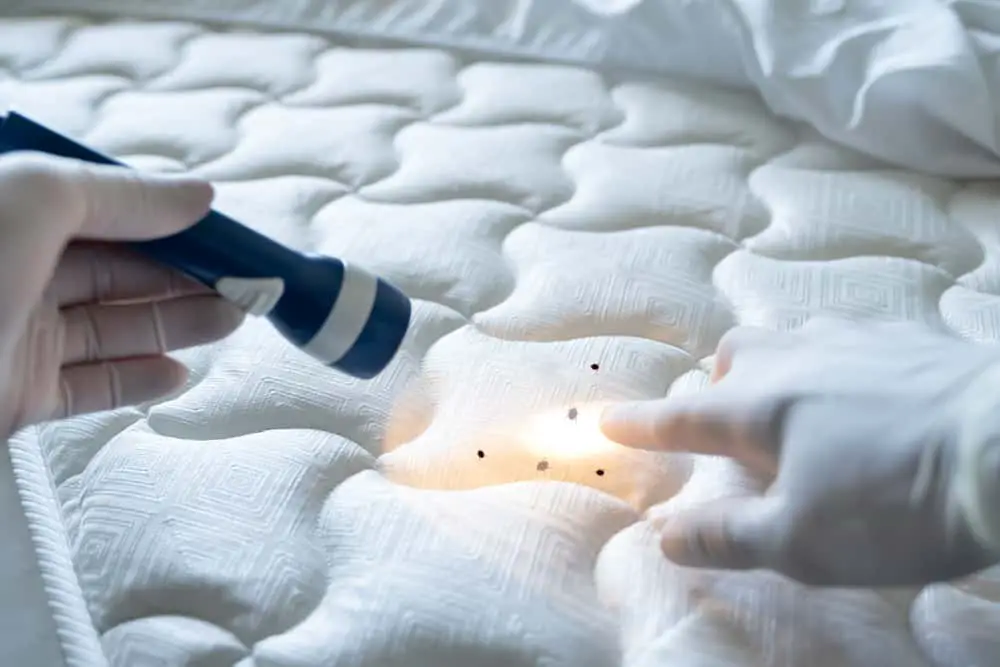Bed bugs can be a serious nuisance for homeowners and renters alike. These tiny, elusive insects are notorious for their ability to survive extreme conditions and hitchhike from one place to another, making eradication a challenging task.
One question that might arise when trying to tackle a bed bug problem is whether or not they can drop from the ceiling, causing further distress to those suffering from an infestation.
Typically, they will hide in small cracks and crevices near beds, furniture, and other resting areas. However, it’s not unheard of for bed bugs to venture farther away, including walls and ceilings, especially in more extensive or challenging infestations.
Keep in mind that while it is possible for bed bugs to be found on ceilings, it is relatively rare. Their presence in atypical locations may indicate a more severe infestation that requires professional assistance.
Bed Bug Behavior and Infestations
How Bed Bugs Live and Travel
Bed bugs are small, wingless insects that feed on human blood, which they require to grow and reproduce. They often live close to their food source, which is typically in the bedroom of a residential home.
Bed bugs are known to be very good at hiding, with their flat bodies enabling them to fit into the smallest of cracks, crevices, and even electrical sockets. They tend to be more active at night due to their preference for darkness.
Although bed bugs cannot fly or jump, they are able to crawl quite quickly across floors, walls, and even ceilings. They can also travel between rooms by hitchhiking on items such as clothing, luggage, and furniture or through shared walls in apartment buildings.
Infestation Characteristics
The presence of bed bugs in a home can be determined by a variety of signs, including:
- Bites: Bed bug bites are red, itchy, and often appear in clusters or lines on the skin. However, not everyone reacts to bed bug bites, so this alone may not confirm an infestation.
- Fecal Spots: Small, black, or dark brown spots on mattresses, bedding, or walls near the bed might indicate bed bug fecal matter.
- Nymphs and Eggs: Bed bugs shed their skin multiple times as they grow, and these shed skins may be visible around their hiding places. Additionally, tiny, white eggs can be found nestled in crevices and seams of furniture or mattresses.
- Active Movement: Spotting live bed bugs in action, especially during nighttime, is a clear indication of an infestation.
Given their natural tendency to hide and their ability to crawl across many surfaces, it is possible to find bed bugs dropping from the ceiling as they travel during their nightly search for a blood meal.
However, this is relatively rare since bed bugs generally prefer to reside closer to the bed, where their human hosts sleep. In order to prevent a bed bug infestation, it’s essential to regularly inspect your home for signs of their presence and take action as necessary.
Signs of Bed Bugs and Detection

Visual Signs of Bed Bugs
One of the key steps in managing bed bugs is to be able to identify them. The following are some common visual signs of bed bugs:
- Dark spots: These could be bed bug feces, which appear as small dark spots on mattress seams, bedding, or nearby walls.
- Stains: Bed bugs might leave behind rusty, reddish-brown stains on bedding, mattresses, or other surfaces after being accidentally crushed.
- Mold: Although mold itself is not a sign of bed bugs, the presence of mold can indicate high humidity, which might attract bed bugs to an area.
Inspection and Early Detection
Inspection and early detection of bed bugs help in controlling their spread and managing the infestation.
Here are some ways to detect bed bugs:
- Musty odor: Bed bugs release an unpleasant musty odor through the glands on their bodies. If you notice a persistent musty smell in a room, it may be due to bed bugs.
- Bed bug bites: Bed bug bites are small, red, and often appear in a cluster or a line. They can cause itching and discomfort and could be an indicator of bed bugs’ presence.
- Bed bugs on ceiling: Though it’s rare, bed bugs can be found on ceilings, especially if they are dropping from higher points in a room or along walls.
- Allergic reaction: Some people may experience an allergic reaction to bed bug bites, which might include swelling, redness, and itching.
- Where do bed bugs hide? Bed bugs tend to hide in small cracks and crevices, like mattress seams, box springs, bed frames, and baseboards. Regular inspection of these areas can help detect bed bugs early.
Prevention and Control Measures
Bed Bug Treatment and Extermination
To effectively control bed bug infestations, a combination of methods is often recommended. Heat treatment, which involves heating the infested area to temperatures lethal to bed bugs, is a non-chemical option. This method is especially useful for multi-unit buildings, like apartments, where bed bugs can travel between units.
For persistent infestations, using insecticides is a common approach. However, it’s essential to consult with a professional pest control service, as they are knowledgeable about the appropriate chemicals to use and application methods. Some chemicals, such as diatomaceous earth, can also be used by individuals to target bed bugs hiding in cracks and crevices.
Preventive Actions
Prevention is key to avoiding bed bug issues in the first place. Some preventive measures include:
- Inspect luggage when returning from trips, as bed bugs can hitchhike from hotels or other accommodations.
- Before bringing used furniture into your home, thoroughly examine it for signs of bed bugs.
- In multi-unit buildings, communication between tenants and the landlord is crucial for reporting and addressing infestations.
Home Care
Maintaining a clean and organized home can also help prevent bed bug infestations. Here are some practical tips:
- Regularly vacuum your floors, furniture, and bed, paying close attention to cracks and crevices where bed bugs may hide.
- Use protective covers on your mattress and box spring to prevent bed bugs from settling in these areas.
- Essential oils, such as lavender and eucalyptus, can act as natural repellents. However, they should never be relied upon as a sole treatment method.
By employing bed bug treatment and prevention strategies, you can help protect your living space from these unwelcome pests.
Bed Bug Habitats and Hiding Spots

Bed bugs (Cimex lectularius) are notorious pests that can infest various areas in homes and hotels. To understand how they might drop from the ceiling, it’s crucial to first examine their usual habitats and hiding spots.
Common Hiding Places in Homes
Bed bugs typically target areas close to their food source – that is, sleeping humans. They can be found in:
- Mattresses and box springs: These pests often hide within the seams, folds, and corners of mattresses and box springs.
- Bed frames and headboards: Both wooden and metal bed frames can provide suitable hiding spots, especially in gaps and crevices.
- Furniture: Couches, chairs, and other upholstered furniture are also bed bug favorites, particularly near the seams and underneath cushions.
- Bedding and curtains: Fabrics with folds and overlaps offer excellent hiding places.
- Baseboards and carpets: The pests can be found in the gaps between baseboards and walls or even under carpets.
- Ceilings and walls: Bed bugs can climb onto ceilings and walls, hiding in cracks and eggshells, particularly in corners.
Outdoor and Unusual Locations
Although bed bugs prefer indoor environments, they can occasionally be found outdoors or in uncommon locations. Some examples include:
- Bat bugs: These close relatives of bed bugs tend to reside in attics where bats dwell.
- Woodpiles: Outdoor stacks of wood or lumber can sometimes harbor bed bugs.
- Neighbors’ homes: In multi-unit buildings, these pests can move between units, traveling along electrical wiring and pipes.
- Public transport: Infestations have been reported on buses, trains, and even airplanes.
Seal any gaps in your home and use tools like interceptors and steam to help prevent bed bug infestations. If you notice itchy bites or reddish-brown insects in your home, it’s essential to seek professional bed bug extermination. Awareness of bed bug habits and hiding spots can help maintain a clean and comfortable living space.


